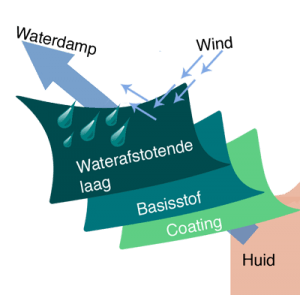Even when you walk at a moderate pace your body perspires. And that’s a good thing. Perspiration is the body’s climate control. When you sweat, your body can cool down. This water vapor has to be transported away from your body so that the transpiration process can continue and your body doesn’t become too warm. If the air against your skin becomes saturated with water vapor, the process is stopped; the body is still sweating intensely but it doesn’t cool down because it can’t get rid of the heat. In effect, you are overheating.
The extent to which a garment wicks perspiration is also referred to as the breathability. The core of this breathability is an advanced membrane, a thin film or layer. There are different kinds of membranes working in different ways. The most often used is the micro-porous membrane (Gore-Tex for example), consisting of a film with millions of microscopic holes per square centimeter. This membrane is laminated to an outer fabric, heat sealed to form a strong fabric/laminate, from which the jacket can be manufactured. Other membranes such as Dermizax are hydrophobic membranes, where the movement of molecule transports moisture away from the body. The higher the activity of the molecules the higher the breathability.
When the air pressure outside of the jacket is lower than on the inside, the moist air inside of your jacket is ‘sucked’ through the membrane. This will happen when the air inside the jacket is warmer than the air outside of the jacket. Also, if wind passes at high speed over the outside of the jacket, you will see a slight negative pressure.
It is good to realize that there always will be situations where even a hard shell won’t perform miracles. This applies to tropical hot and humid environments; the jacket will still be very waterproof, but the breathability will be less effective. And there limits to how much moist air can be transported through a membrane. If you are doing a very high-intensity activity, sometimes even the most technically advanced jacket unable to keep you dry and comfortable.
What is important to point out is that a good hardshell doesn’t make your body sweat less (you can sometimes hear people say this), but that it deals with your transpiration much better so that your base-layer or mid layer does not get wet. This also means that the breathability of your expensive hardshell is only so good as the quality of the other layers you are wearing. If for example, you wear a cotton t-shirt against your body, you are quite screwed, no matter how good your mid layer or hardshell is. Cotton holds on to moisture like a pitbull. As a result, you will feel wet and miserable.
Repellent Power (Durable Water Repellency)
A hard shell should be impervious to rain. On the one hand, it is the feature of the membrane, the micropores being so small that water droplets cannot pass through them (even though water vapor will). In addition to that, in many cases, a DWR (Durable Water Repellent) coating is applied. The physics of this strong water repellency lies in the attraction of water molecules (cohesion forces) that ensures that the water molecules stick together. The DWR coating is absorbed by the fibers of the material, making the surface tension of the fabric higher. That ensures that water droplets are not absorbed by the fabric, and rather forms droplets that will easily roll off of the material.
What we want to point out at this stage, is that many DWR coatings are from a climate point of view, not a very durable solution. That is why more and more brands are not using DWR or looking for environmentally friendly versions of DWR coatings.
What not many people realize, is that you have to regularly wash your hardshell gear to retain or in some cases restore the technical quality of the jacket. Mainly because the membrane can become clogged with dust/dirt, but also because the water-repellent capacity needs to be revitalized regularly.
If you don’t maintain your gear chances are that the material will eventually soak in the rain.
Another consequence is that the membrane no longer wicks the perspiration vapor so that it condenses on the inside. If you have neglected your maintenance, you’ll notice it so soon enough by the clammy feeling during exercise and you keep feeling sweaty.
So you should stay ahead of the game. Hardshells you can be washed in the washing machine provided you pay attention to some issues. More about that further in this GearGuide under the “care & maintenance” heading. It is important never to use regular detergents as thesewilll almost always affect the technical quality of your jacket.




